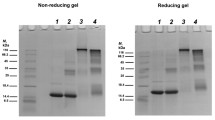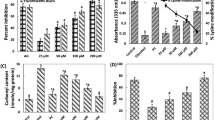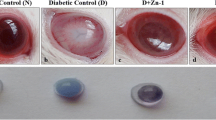Abstract
The elevated lenticular level of methylglyoxal (MGO) in diabetic patients is an important risk factor for the development of age-related (senile) cataract disorders. Carnosine (β-alanyl L-histidine), a natural antioxidant dipeptide product, has been indicated to prevent the development of cataract diseases. Therefore, it is possible that the anti-cataract activity of this naturally occurring compound is mediated by its anti-glycoxidation effect. In this study, the eye lens proteins were treated with MGO in the presence of carnosine. Then, sodium dodecyl sulfate polyacrylamide gel electrophoresis (SDS-PAGE) analysis and several spectroscopic evaluations were used with the aim to investigate the possible inhibitory activity of carnosine against the MGO-induced structural damages of eye lens proteins. Our results indicated that MGO causes a substantial structural alteration in the lens proteins. The results of fluorescence assessments also suggested that MGO-induced structural changes were accompanied with the formation of additional chromophores in the protein structure. Also, in the presence of carnosine, a notable reduction in the protein structural damages was observed. Our results may highlight an important protective role of carnosine against MGO-induced structural insults in the lens proteins. This study suggests carnosine supplementation as a possible preventive strategy against development of the diabetic cataracts in human.










Similar content being viewed by others
References
Bloemendal, H., de Jong, W., Jaenicke, R., Lubsen, N. H., Slingsby, C., & Tardieu, A. (2004). Ageing and vision: structure, stability and function of lens crystallins. Progress in Biophysics and Molecular Biology, 86(3), 407–485.
Stadtman, E. R. (1992). Protein oxidation and aging. Science, 257(5074), 1220–1224.
Brownlee, M. (2001). Biochemistry and molecular cell biology of diabetic complications. Nature, 414(6865), 813.
Lyons, T. J., Silvestri, G., Dunn, J. A., Dyer, D. G., & Baynes, J. W. (1991). Role of glycation in modification of lens crystallins in diabetic and nondiabetic senile cataracts. Diabetes, 40(8), 1010–1015.
Yim, G., & Wang, H. H. (2007). Antibiotics as signalling molecules. Philosophical Transactions of the Royal Society B: Biological Sciences, 362(1483), 1195–1200.
Nita, M., & Grzybowski, A. (2016). The role of the reactive oxygen species and oxidative stress in the pathomechanism of the age-related ocular diseases and other pathologies of the anterior and posterior eye segments in adults. Oxidative Medicine and Cellular Longevity, 2016, 3164734.
Kador, P., Akagi, Y., Terubayashi, H., Wyman, M., & Kinoshita, J. (1988). Prevention of pericyte ghost formation in retinal capillaries of galactose-fed dogs by aldose reductase inhibitors. Archives of Ophthalmology, 106(8), 1099–1102.
Varma, S., & Kinoshita, J. (1974). Sorbitol pathway in diabetic and galactosemic rat lens. Biochimica et Biophysica Acta (BBA)-General Subjects, 338(2), 632–640.
Kinoshita, J. H. (1974). Mechanisms initiating cataract formation proctor lecture. Investigative Ophthalmology & Visual Science, 13(10), 713–724.
Ramasamy, R., Yan, S. F., & Schmidt, A. M. (2006). Methylglyoxal comes of AGE. Cell, 124(2), 258–260.
Seidler, N. W. (2012). GAPDH: biological properties and diversity. Springer, Dordrecht, 985, 1–36.
Ahmed, N., Thornalley, P. J., Dawczynski, J., Franke, S., Strobel, J., Stein, Gn, & Haik, G. M. (2003). Methylglyoxal-derived hydroimidazolone advanced glycation end-products of human lens proteins. Investigative Ophthalmology & Visual Science, 44(12), 5287–5292.
Jack, M., & Wright, D. (2012). Role of advanced glycation endproducts and glyoxalase I in diabetic peripheral sensory neuropathy. Translational Research, 159(5), 355–365.
Vicente Miranda, H., El‐Agnaf, O., & Outeiro, T. F. (2016). Glycation in Parkinson’s disease and Alzheimer’s disease. Movement Disorders, 31(6), 782–790.
Thornalley, P. J. (2008). Protein and nucleotide damage by glyoxal and methylglyoxal in physiological systems-role in ageing and disease. Drug Metabolism and Drug Interactions, 23(1-2), 125–150.
Vistoli, G., De Maddis, D., Cipak, A., Zarkovic, N., Carini, M., & Aldini, G. (2013). Advanced glycoxidation and lipoxidation end products (AGEs and ALEs): an overview of their mechanisms of formation. Free Radical Research, 47, 3–27.
Boldyrev, A. (1993). Does carnosine possess direct antioxidant activity? The International Journal of Biochemistry, 25(8), 1101–1107.
Brownson, C., & Hipkiss, A. R. (2000). Carnosine reacts with a glycated protein. Free Radical Biology and Medicine, 28(10), 1564–1570.
Hobart, L. J., Seibel, I., Yeargans, G. S., & Seidler, N. W. (2004). Anti-crosslinking properties of carnosine: significance of histidine. Life Sciences, 75(11), 1379–1389.
Boldyrev, A., Formazyuk, V., & Sergienko, V. D. (1994). Biological significance of histidine-containing dipeptides with special reference to carnosine: chemistry, distribution, metabolism and medical applications. Physicochem Biol, 13, 1–60.
Quinn, P. J., Boldyrev, A. A., & Formazuyk, V. E. (1992). Carnosine: its properties, functions and potential therapeutic applications. Molecular Aspects of Medicine, 13(5), 379–444.
Hipkiss, A. R., Michaelis, J., & Syrris, P. (1995). Non-enzymatic glycosylation of the dipeptide L-carnosine, a potential anti-protein-cross-linking agent. FEBS Letters, 371(1), 81–85.
Khalili-Hezarjaribi, H., Yousefi, R., & Moosavi-Movahedi, A. A. (2012). Effect of temperature and ionic strength on structure and chaperone activity of glycated and non-glycated alpha-crystallins. Protein and Peptide Letters, 19(4), 450–457.
Kumar, P. A., Kumar, M. S., & Reddy, G. B. (2007). Effect of glycation on α-crystallin structure and chaperone-like function. Biochemical Journal, 408(2), 251–258.
Fayle, S. E., Healy, J. P., Brown, P. A., Reid, E. A., Gerrard, J. A., & Ames, J. M. (2001). Novel approaches to the analysis of the Maillard reaction of proteins. Electrophoresis, 22(8), 1518–1525.
Khazaei, S., Yousefi, R., & Alavian-Mehr, M. M. (2012). Aggregation and fibrillation of eye lens crystallins by homocysteinylation; implication in the eye pathological disorders. The Protein Journal, 31(8), 717–727.
Schägger, H., & Von Jagow, G. (1987). Tricine-sodium dodecyl sulfate-polyacrylamide gel electrophoresis for the separation of proteins in the range from 1 to 100 kDa. Analytical Biochemistry, 166(2), 368–379.
Kumar, P. A., Reddy, P. Y., Srinivas, P., & Reddy, G. B. (2009). Delay of diabetic cataract in rats by the antiglycating potential of cumin through modulation of α-crystallin chaperone activity. The Journal of Nutritional Biochemistry, 20(7), 553–562.
Qadeer, A., Zaman, M., & Khan, R. (2014). Inhibitory effect of post-micellar SDS concentration on thermal aggregation and activity of papain. Biochemistry (Moscow), 79(8), 785–796.
Musci, G., & Berliner, L. J. (1985). Probing different conformational states of bovine α-Lactalbumin: fluorescence studies with 4,4’-Bis[1-(phenylamino)-8-naphthalenesulfonate]. Biochemistry, 24(15), 3852–3856.
Fan, X., & Monnier, V. M. (2008). Nucleophilic compounds decrease advanced glycation end products (AGEs) from ascorbic acid in the hSVCT2 transgenic mouse model of lenticular aging. Investigative Ophthalmology & Visual Science, 49(11), 4945.
Kessel, L., Kalinin, S., Nagaraj, R. H., Larsen, M., & Johansson, L. B. A. (2002). Time‐resolved and steady‐state fluorescence spectroscopic studies of the human lens with comparison to Argpyrimidine, Pentosidine and 3‐OH‐kynurenine. Photochemistry and Photobiology, 76(5), 549–554.
Kelly, S. M., Jess, T. J., & Price, N. C. (2005). How to study proteins by circular dichroism. Biochimica et Biophysica Acta (BBA)-Proteins and Proteomics, 1751(2), 119–139.
Bouchard, M., Zurdo, J., Nettleton, E. J., Dobson, C. M., & Robinson, C. V. (2000). Formation of insulin amyloid fibrils followed by FTIR simultaneously with CD and electron microscopy. Protein Science, 9(10), 1960–1967.
Zako, T., Sakono, M., Hashimoto, N., Ihara, M., & Maeda, M. (2009). Bovine insulin filaments induced by reducing disulfide bonds show a different morphology, secondary structure, and cell toxicity from intact insulin amyloid fibrils. Biophysical Journal, 96(8), 3331–3340.
Datiles, M. B., Ansari, R. R., Suh, K. I., Vitale, S., Reed, G. F., Zigler, J. S., & Ferris, F. L. (2008). Clinical detection of precataractous lens protein changes using dynamic light scattering. Archives of Ophthalmology, 126(12), 1687–1693.
Zhou, C., Qi, W., Lewis, E. N., & Carpenter, J. F. (2015). Concomitant raman spectroscopy and dynamic light scattering for characterization of therapeutic proteins at high concentrations. Analytical Biochemistry, 472, 7–20.
Ghahramani, M., Yousefi, R., Khoshaman, K., & Alavianmehr, M. M. (2015). The impact of calcium ion on structure and aggregation propensity of peroxynitrite-modified lens crystallins: new insights into the pathogenesis of cataract disorders. Colloids and Surfaces B: Biointerfaces, 125, 170–180.
Ghahramani, M., Yousefi, R., Khoshaman, K., Moghadam, S. S., & Kurganov, B. I. (2016). Evaluation of structure, chaperone-like activity and protective ability of peroxynitrite modified human α-crystallin subunits against copper-mediated ascorbic acid oxidation. International Journal of Biological Macromolecules, 87, 208–221.
DiMauro, M. A., Nandi, S. K., Raghavan, C. T., Kar, R. K., Wang, B., Bhunia, A., Nagaraj, R. H., & Biswas, A. (2014). Acetylation of Gly1 and Lys2 promotes aggregation of human γD-crystallin. Biochemistry, 53(46), 7269–7282.
Nagaraj, R. H., Nahomi, R. B., Shanthakumar, S., Linetsky, M., Padmanabha, S., Pasupuleti, N., Wang, B., Santhoshkumar, P., Panda, A. K., & Biswas, A. (2012). Acetylation of αA-crystallin in the human lens: Effects on structure and chaperone function. Biochimica et Biophysica Acta (BBA)-Molecular Basis of Disease, 1822(2), 120–129.
Raman, B., Ramakrishna, T., & Rao, C.M. (1995). Rapid refolding studies on the chaperone-like α-crystallin effect of α-crystallin on refolding of β-and γ-crystallins. Journal of Biological Chemistry, 270(34), 19888–19892.
Khoshaman, K., Yousefi, R., Tamaddon, A. M., Saso, L., & Moosavi-Movahedi, A. A. (2015). The impact of hydrogen peroxide on structure, stability and functional properties of human R12C mutant αA-crystallin: the imperative insights into pathomechanism of the associated congenital cataract incidence. Free Radical Biology and Medicine, 89, 819–830.
Linetsky, M., Shipova, E., Cheng, R., & Ortwerth, B. J. (2008). Glycation by ascorbic acid oxidation products leads to the aggregation of lens proteins. Biochimica et Biophysica Acta (BBA)-Molecular Basis of Disease, 1782(1), 22–34.
Perry, R. E., Swamy, M., & Abraham, E. (1987). Progressive changes in lens crystallin glycation and high-molecular-weight aggregate formation leading to cataract development in streptozotocin-diabetic rats. Experimental Eye Research, 44(2), 269–282.
Schmid, F. X. (2001). Biological macromolecules: UV‐visible spectrophotometry. Encyclopedia of Life Sciences; Macmillan Publisher Ltd, New York, 1–4.
Coussons, P. J., Jacoby, J., McKay, A., Kelly, S. M., Price, N. C., & Hunt, J. V. (1997). Glucose modification of human serum albumin: a structural study. Free Radical Biology and Medicine, 22(7), 1217–1227.
Münch, G., Keis, R., Weßels, A., Riederer, P., Bahner, U., Heidland, A., Niwa, T., Lemke, H. D., & Schinzel, R. (1997). Determination of advanced glycation end products in serum by fluorescence spectroscopy and competitive ELISA. Clinical Chemistry and Laboratory Medicine, 35(9), 669–678.
Cheng, R., Feng, Q., Argirov, O. K., & Ortwerth, B. J. (2005). K2P—A novel cross‐link from human lens protein. Annals of the New York Academy of Sciences, 1043(1), 184–194.
Khan, M. A., Arif, Z., Khan, M. A., & Alam, K. (2018). Methylglyoxal produces more changes in biochemical and biophysical properties of human IgG under high glucose compared to normal glucose level. PLoS ONE, 13(1), e0191014.
Hawe, A., Sutter, M., & Jiskoot, W. (2008). Extrinsic fluorescent dyes as tools for protein characterization. Pharmaceutical Research, 25(7), 1487–1499.
Plaxco, K. W., Simons, K. T., Ruczinski, I., & Baker, D. (2000). Topology, stability, sequence, and length: defining the determinants of two-state protein folding kinetics. Biochemistry, 39(37), 11177–11183.
Nakamura, Y., Fukiage, C., Shih, M., Ma, H., David, L. L., Azuma, M., & Shearer, T. R. (2000). Contribution of calpain Lp82–induced proteolysis to experimental cataractogenesis in mice. Investigative Ophthalmology & Visual Science, 41(6), 1460–1466.
Biswas, S., Harris, F., Dennison, S., Singh, J. P., & Phoenix, D. (2005). Calpains: enzymes of vision? Medical Science Monitor, 11(9), 301–310.
Tamada, Y., Fukiage, C., Nakamura, Y., Azuma, M., Kim, Y., & Shearer, T. (2000). Evidence for apoptosis in the selenite rat model of cataract. Biochemical and Biophysical Research Communications, 275(2), 300–306.
Robertson, L. J., David, L. L., Riviere, M. A., Wilmarth, P. A., Muir, M. S., & Morton, J. D. (2008). Susceptibility of ovine lens crystallins to proteolytic cleavage during formation of hereditary cataract. Investigative Ophthalmology & Visual Science, 49(3), 1016–1022.
Bellier, J., Nokin, M. J., Lardé, E., Karoyan, P., Peulen, O., Castronovo, V., & Bellahcène, A. (2019). Methylglyoxal, a potent inducer of AGEs, connects between diabetes and cancer. Diabetes Research and Clinical Practice, 148, 200–211.
Aydin, F., Kalaz, E. B., Kucukgergin, C., Coban, J., Dogru-Abbasoglu, S., & Uysal, M. (2018). Carnosine treatment diminished oxidative stress and glycation products in serum and tissues of D-galactose-treated rats. Current Aging Science, 11(1), 10–15.
Sahin, S., Uylaş, U., Sahinturk, V., & Alatas, O. (2018). Protective effect of carnosine on hepatic ischemia-reperfusion injury in rats. Osmangazi Tıp Dergisi, https://doi.org/10.20515/otd.481714.
Javadi, S., Yousefi, R., Hosseinkhani, S., Tamaddon, A. M., & Uversky, V.N. (2017). Protective effects of carnosine on dehydroascorbate-induced structural alteration and opacity of lens crystallins: Important implications of carnosine pleiotropic functions to combat cataractogenesis. Journal of Biomolecular Structure and Dynamics, 35(8), 1766–1784.
Carroll, L., Karton, A., Radom, L., Davies, M. J., & Pattison, D. I. (2019). Carnosine and carcinine derivatives rapidly react with hypochlorous acid to form chloramines and dichloramines. Chemical Research in Toxicology, 32(3), 513–525.
Xing, L., Chee, M. E., Zhang, H., Zhang, W., & Mine, Y. (2019). Carnosine—a natural bioactive dipeptide: bioaccessibility, bioavailability and health benefits. Journal of Food Bioactives, 5, 8–17.
Freund, M. A., Chen, B., & Decker, E. A. (2018). The inhibition of advanced glycation end products by carnosine and other natural dipeptides to reduce diabetic and age‐related complications. Comprehensive Reviews in Food Science and Food Safety, 17(5), 1367–1378.
Preedy, V. R. (2015). Imidazole dipeptides: chemistry, analysis, function and effects. In Royal Society of Chemistry. RSC Publishing, Cambridge, 217–237.
Acknowledgements
We appreciatively acknowledge the financial support of Shiraz University Research Council, Iran National Science foundation (INSF) and National Institute for Medical Research Development (NIMAD).
Funding
This work was supported by INSF (grant number 96008461) and NIMAD (grant number 964854).
Author information
Authors and Affiliations
Corresponding author
Ethics declarations
Conflict of Interest
The authors declare that they have no conflict of interest.
Additional information
Publisher’s note Springer Nature remains neutral with regard to jurisdictional claims in published maps and institutional affiliations.
Rights and permissions
About this article
Cite this article
Kianpour, M., Yousefi, R. Carnosine Prevents Different Structural Damages Induced by Methylglyoxal in Lens Crystallins. Cell Biochem Biophys 77, 343–355 (2019). https://doi.org/10.1007/s12013-019-00884-3
Received:
Accepted:
Published:
Issue Date:
DOI: https://doi.org/10.1007/s12013-019-00884-3




